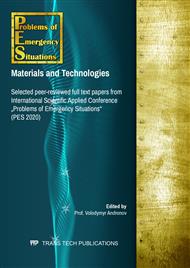[1]
E. Zini, Green composites: An overview, Polymer Composites, 32, 12 (2011) 1905–(1915).
DOI: 10.1002/pc.21224
Google Scholar
[2]
N. A. Kengkhetkit, T. Amornsakchai, A new approach to Greening, plastic composites using pineapple leaf waste for performance and cost effectiveness, Materials & Design, 55 (2014) 292–299.
DOI: 10.1016/j.matdes.2013.10.005
Google Scholar
[3]
G. Vaickelionis, V. Valanciene, Lightweight concrete with an agricultural waste – buckwheat hulk, Materials Science (MEDZIAGOTURA), 22, 1 (2016) 98−104.
Google Scholar
[4]
Ya. Koval'chuk, G. Kramar, L. Bodrova, I. Koval', S. Marynenko, Thermal insulation building materials from local process wastes, Mizhvuzivs'kyi zbirnyk NAUKOVI NOTATKY,, 66 (2019) 165−171.
Google Scholar
[5]
N. F. Zaaba & H. Ismail, Thermoplastic/natural filler composites: A short review, J. Phys. Sci., 30, 1 (2019) 81−99.
Google Scholar
[6]
O. Fomin, A. Lovska, V. Masliyev, A. Tsymbaliuk, O. Burlutski, Determining strength indicators for the bearing structure of a covered wagon's body made from round pipes when transported by a railroad ferry, Eastern-European J. of Enterprise Tech., 7, 1 (97) (2019) 33−40.
DOI: 10.15587/1729-4061.2019.154282
Google Scholar
[7]
Yu. Danchenko, M. Kachomanova, Ye. Barabash, The acid-base interaction role in the processes of the filled diane epoxy resin structuring, Chemistry and Chemical Tech., 12, 2 (2018) 188−195.
DOI: 10.23939/chcht12.02.188
Google Scholar
[8]
Z. Nor Fasihah, I. Hanafi, Natural filler composites: a short review, Journal of Physical Science, 30 (1) (2019) 81−99.
Google Scholar
[9]
A. E. Shkuro, V. V. Glukhikh, N. M. Mukhin, Obtaining and studying wood-polymer composites with fillers from waste of plant origin, Lesnoi vestnik, 3 (2016) 101–105.
Google Scholar
[10]
N. Petchwattana, S. Covavisaruch, Effects of rice hull particle size and content on the mechanical properties and visual appearance of wood plastic composites prepared from poly(vinyl chloride), J. of Bionic Engineering, 10, 1 (2013) 110−117.
DOI: 10.1016/s1672-6529(13)60205-x
Google Scholar
[11]
L. A. Lim, D. A. Makeich, N. A. Prishchenko, A. M. Zabolotnaia, V. A. Reutov, Ye. V. Koval'ova, Obtaining lignocellulosic polymer composites based on buckwheat husk and polyethylene, International J. of Applied and Experimental Research, 6 – 3 (2015) 514−514а.
Google Scholar
[12]
M. A. Binhussain, M. M. El-Tonsy, Palm leave and plastic waste wood composite for outdoor structures, Construction and Building Materials, 47 (2013) 1431–1435.
DOI: 10.1016/j.conbuildmat.2013.06.031
Google Scholar
[13]
R. Campbell Murdi, M. Mak, M. Misra, A. K. Mohanty, An in-depth analysis of the physical-mechanical properties imparted by agricultural fibers and food processing residues in polypropylene biocomposites, AIP Conference Proceedings, 1664, 150007 (2015).
DOI: 10.1063/1.4918503
Google Scholar
[14]
J. Andrzejewski, M. Barczewski, M. Szostak, Injection molding of highly filled polypropylene-based biocomposites. Buckwheat husk and wood flour filler: a comparison of agricultural and wood industry waste utilization, Polymers, 11, 1881 (2019).
DOI: 10.3390/polym11111881
Google Scholar
[15]
Yu. Danchenko, V. Andronov, A. Kariev, V. Lebedev, E. Rybka, R. Meleshchenko, D. Yavorska, Research into surface properties of dispersive fillers based on plant raw materials, Eastern-European J. of Enterprise Tech., 5, 12(89) (2017) 20−26.
DOI: 10.15587/1729-4061.2017.111350
Google Scholar
[16]
Yu. Danchenko, A. Kariev, V. Andronov, A. Cherkashina, V. Lebedev, T. Shkolnikova, O. Burlutskyi, A. Kosse, Yu. Lutsenko, D. Yavors'ka, Research of chemical nature and surface properties of plant disperse fillers, Eastern-European J. of Enterprise Tech., 6, 1(103) (2020) 32−41.
DOI: 10.15587/1729-4061.2020.193383
Google Scholar


